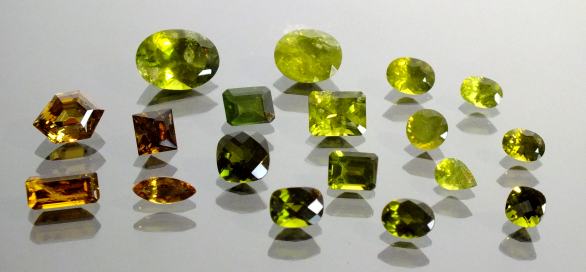 |
| 様々な産地からのベスブ石ルース (Faceted
vesuvianites from various localities) 0.62 - 4.95ct |
べスブ石 (Vesuvianite)
〔 アイドクレーズ (Idocrase) 〕
 |
| 様々な産地からのベスブ石ルース (Faceted
vesuvianites from various localities) 0.62 - 4.95ct |
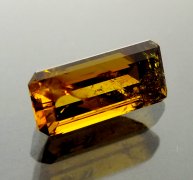 |
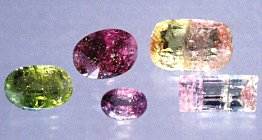 |
 |
 |
| 2.60ct 10.9x5mm
0.48 - 2.79ct Jeffrey Mine |
2.15ct 9x7mm
2.25ct ea. Black Lake |
||
| Quebec, Canada | |||
 |
||
| 3.24ct 11.6x7.9mm | 1.44ct 8.6x5.8mm | 0.81ct 9.6x4.2mm |
| Kajiado,Kenya | ||
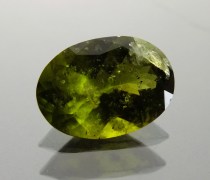 |
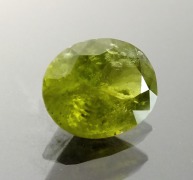 |
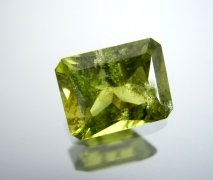 |
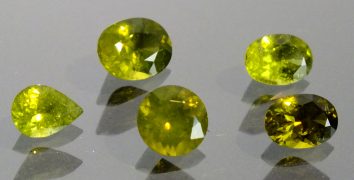 |
| 4.95ct 13.9x10.0mm | 3.65ct 11.05x9.0mm | 2.68ct 9.05x7.10mm | 0.62ct(6.85x4.85mm) - 1.28ct(7.0x6.0mm) |
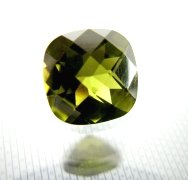 |
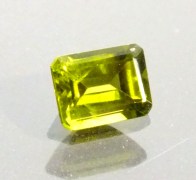 |
 |
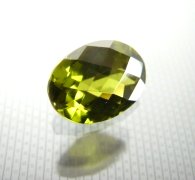 |
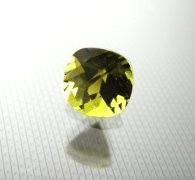 |
| 2.21ct 8.2mm | 1.50ct 7.9x6.2mm | 1.82ct 8.1x6.1mm | 1.32ct 8.1x6.1mm | 1.29ct 6.3mm |
| Magadi, Kenya | ||||
 |
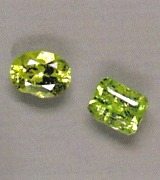 |
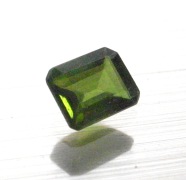 |
| 1.51ct 6.4mm | ea. 0.25ct | 1.64ct 7.7x6.2mm |
| Montesoma,Volcan
Vesuvio Italia |
Madagascar | Rep. of South Africa |
| イタリア・アルプスのベスブ石(Vesuvianite from Italian Alps) | |||||
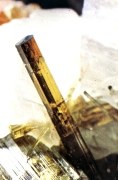 |
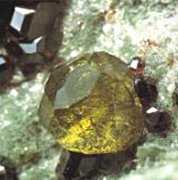 |
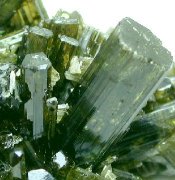 |
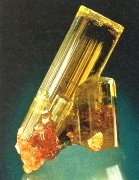 |
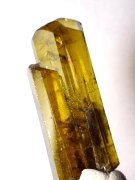 |
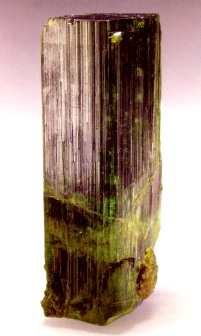 |
| 10mm Val Tremmogge |
柘榴石を伴うベスブ石
4mm Vesuvianite with garnet Val Malenco |
20mm Bellecombe, | 33x13x3mm Val d'Aosta |
V 22mm Val d'Sussa |
13.5x4x5cm Val
d'Ala デヴォンシャー・コレクション Devonshire Collection |
| Italia | |||||
最初に発見されたヴェスヴィオ火山に因んで命名された鉱物ですが、ヨーロッパ・アルプスの、特にイタリア・アルプスの各地からも見事な結晶が発見されます。
上の写真右端の結晶は18〜19世紀にかけて鉱山開発や宝石研磨鉱業を推進したイギリスのデヴォンシャー公爵の鉱物コレクションからのものです。
この結晶は1834年5月7日のオークションで公爵が ”最も価値のある結晶” として入手しました。
イタリア・ピエモンテ州のアラ渓谷産のベスブ石としては今日に至るまで最大の結晶です。
Although vesuvianite was first deiscovered and named after Vesuvio volcan, varieties of superb crystals are discovered from Italian Alps regions. Right end photo of above is from the Devonshire Mineral Collection. Duke of Devonshire, well known as mine owners and supporters of the local mining and lapidary industries, bought this specimen from the Henry Heuland auction of 7 May 1834 as "The most valuable crystal known". This crystal is still one of the largest vesuvianites known from Ala, Piemonte, Italiy.
| カナダのベスブ石(Canadian vesuvianite) | |||
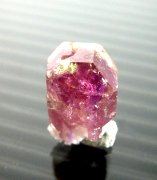 |
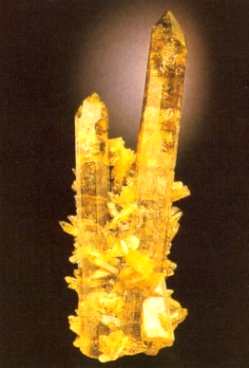 |
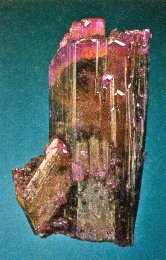 |
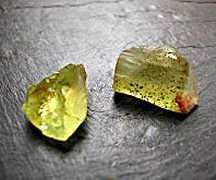 |
| 15x11x8mm | |||
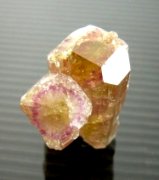 |
|||
| 36x25x35mm | 110mm | 5cm Claus Hedegaard Collection |
宝石質結晶片(gemmy
crystals) 18mm |
| Jeffrey Mine, Asbestos | Black Lake | ||
| Quebec, Canada | |||
| 化学組成(Composition) | 結晶形 (Crystal System) |
モース硬度 (Hardness) |
比重 (Density) |
屈折率 (Refractive Index) |
| Ca19(Al,Mg,Fe)13Si18O68(OH,F,O)10 | 正方晶系 (Tetragonal) |
6½ | 3.30-50 | 1.70-75 |
| ベスブ石の結晶形(Vesuvianite's Crystal Forms) | ||||||||
 |
 |
 |
 |
 |
 |
 |
 |
 |
名前と産状(Name and Occurence)
べスブ石の名前は最初に発見されたイタリア・ナポリの近郊にある有名なヴェスヴィオ火山に因み1795年にドイツの地質学者 F. Werner によって命名されました。
ベスブ石にはこの他にギリシア語の ”Eidos :見かけ、Krasis : 混交” に由来するアイドクレースの名で呼ばれることもあります。
この名はフランスの鉱物学者、アウイ(Haüy)によって、結晶の形と色合いとがジルコンや柘榴石等の他の鉱物の結晶と紛らわしいことに由来する命名です。
先にヴェルナーが命名したヴェスヴィアナイトに優先権があるにも拘わらず、依然としてアイドクレーズも平行して使われているのは確かに、他の多くの鉱物結晶と紛らわしい外観と色合いとを持っているこの鉱物に相応しい命名のせいかもしれません。
Vesuvianite was named by German geologist, Franz Werner in 1795, after Mount Vesuvio, where this mineral was first discovered in erupted limestone. In 1799, French mineralogist J. H. Haüy coined the name idocrase, by combining the Greek word "eidos : form or appearance" and "krasis : mixture", appreciating the varied habit and color of crystals.
主にスカルンのような接触交代鉱床や時に山岳性の熱水鉱床に発見される比較的珍しい鉱物ですが、産地により多彩な変種があって、世界各地に産するベスブ石は下記の様に固有の名前で呼ばれます ;
Most vesuvianite is of contact-metamorphic origin, occuring in crystalline limestone at the contact with igneous rock rich in calcium silicates - so-called calc-silicic contacts. They come from deposits such as the famous Lake Jaco in Chihuahua, Mexico, Crestmore quarry(Riverside Co., California, U.S.A.) and 'Othihorongo', north of Uis, in Namibia. A few deposits carry beautiful vesuvianite crystals in so-called epithermal(hydrothermal) veins in serpentine. They include Jeffrey mine, Asbestos, Canada, source of lustrous, elongate, pale green crystals and crystals of either mottled green/pinkish/unsaturated burgundy or purplish red of manganoan vesuvianites. Vesuvianite has lots of variations depending on localities as follows ;
多彩な世界のベスブ石(Vaieties of vesuvianites)
含銅ベスブ石(シプリン)
Cuprian Vesuvianite(Cyprine)方解石とベスブ石(Vesuvianite on calcite)
43x40x25mm 22x20x10ベスブ石結晶 56x42mm
Vesuvianite matrix
Sauland, Telemark, Norway Kajiado, Kenya 長野県川上村甲武信鉱山
Kobushi mine, Nagano, Japan
18mm ヴィリュイ石(Viluite)
Ca19(Al,Mg)13B5Si18O68(O,OH)10
20x14x14mm灰礬柘榴石を伴うベスブ石 6cm
Vesuvianite with grossularite
Sierra de las CrucesNuristan, Afghanistan Vilui River, Siberia, Russia Coahuila, Mexico
カリフォルナイト (Californite) 5.5x6cm カボション(Cabochon) 最大(max) 18x16mm 0.41 - 3.31ct East of Paradise on the Feather River Canyon California, U.S.A.
シプリン
(Cyprine): ノルウェー・テレマーク産の銅を含む青い変種
Copper bearing blue variety, found at Telemark, Norway
カリフォルナイト(Californite) : カリフォルニア翡翠とも呼ばれ半透明の団塊で産し装飾用に用いられる。
Translucent nodule found in California. Used as decorative
material, called as "Californian jade"
クサンサイト
(Xanthite): ニューヨーク州Amityに産する暗黄褐色の種類。ギリシア語の "Xanthos:黄色 "に因む
今日では淡黄緑色のベスブ石がクサンサイトの商業名で呼ばれることがあります。
Dark Yellowish-brown variety found at Amity, New York, U.S.A.
The name derives from Greek word "Xanthos : yellow". Today, greenish yellow vesuvianite is sold under commercial name "Xanthite".
ヴィリュイ石
(Viluite): ロシア、シベリアのヴィリュイ川流域特産の硼素とセリウムを含む暗緑褐色の変種
Dark greenish-brown variety, contains boron and cerium, is recovered only from the Vilui River, Siberia、Russia.
この他にも10種類ほどの変種があるようです。したがって上記の化学組成や比重、屈折率もあくまでも参考。産地によりかなり変動します。
In addition, 10 varieties are reported, with different chemical compositions, hench varied hardnesses and refractive indexes.
宝石質ベスブ石の産地 (Gem vesuvianite localities)
スカルン鉱床や山岳性の熱水鉱床は無数にあるため、産地は広範にありますが量が少なく結晶も5cm程の大きさが最大でファセット・カットが可能な透明な結晶は大変稀です。
したがって典型的なコレクター・ストーンです。
冒頭の20個足らずのルースは比較的に透明度が高いためファセット・カットされてはいますが、しかし亀裂や包有物を多く含み、宝飾用途に使えるのは数個のみです。
が、この程度の品質のルースの蒐集には20年余りかかりました。
宝石質のベスブ石はそれほどに稀な存在です。
宝飾用としては時たま、まとまって発見されるカリフォルナイトが翡翠の代用品として、カボションや彫刻品として市場に出回るくらいです。
2000年には数十年振りにかなりまとまった量のカリフォルナイトが採れました。
透明度が高く珍しくファセット・カットされた程でしたが、20kgの団塊からファッセット級は0.25%、カボション級が5%の歩留まりでした。
Vesuvianite is found widely from numerous scarn deposits and alpine type hydrothermal veins in the world, but volume is limited and crystals are in general small(maximum 5cm long) and transparent gem quality crystals are extremely rare. Hencce vesuvianite is a typical collectors stone.
Californite is recovered sporadically for considerable volume and are carved or is cut as cabochon for jewelery purpose as jade replacement. In the year 2000, considerable volume of californite are recovered since several tenth of years. Some lot is transparent enough to be faceted with as low as 0.25% of yield, while cabochon grade is 5% of yield from 20kg of rough.
かつては稀にケニア産の褐色の透明な結晶がカットされて、コレクター用に市場で見かけることがありました。
2001年春、ナイロビの南部60km のKajiadoとMagadi に新たな産地が発見されペリドット色のファセット石が一時市場に出回りました。1〜2トンの原石が採掘され、その1〜2%が宝石質で最大5カラットほどのルースがカットされました。が産地が国立公園内だったので、間もなく政府により採掘が禁止されました。
同じ頃、カナダ、ケベック州、ブラック湖産のペリドットのような明るい緑色のファセットも出現しました。この鉱山はジェフリー鉱山同様、大規模な露天掘りによるアスベスト鉱山です。
モンレアル(モントリオール)の東北東 200km にありしばしば "LAB (Lake Asbestos Bell) mine" のラベル付きで標本が出回っています。
更に2002年にマダガスカルのトルマリンのパーセル中に混入していた輝かしい緑色の宝石がベスブ石であることが判明しました。この色合いはクロム発色です。
近年南アフリカ産の亜透明〜半透明のベスブ石がインドで研磨され、ベスブ石から訛ったヴァッソナイトの名で大半はカボション、ごく稀にファセット・カットされたものを最近見かけます。
Practically, although quite rare, Kenya has been a unique facetable vesuvianite producer with golden-brownish stone. In 2001, at Kajiado in the rift valley zone, about 60km south of Nairobi, peridote-like vesuvianite was discovered and faceted stone appeared in the market. 1 to 2 tons of rough was recovered with 1 to 2% gemmy part was cut to maximum 5 carat stone.
The mine in National Game Park are, was soon closed by government. At the same period, peridot like bright green appeared from huge scale open pit asbestos mine, located about 200km east-north east from Mont Real, near Black Lake, Quebec, Canada
. Crystal specimens often labeled "LAB : Lake Asbestos Belle mine" is seen in the market.
In 2002、some chromium colored bright green rough, mixed in tourmaline parcel from Madagascar were found to be a gem vesuvianite. Recently, translucent to semi-transparent low quality vesuvianites, mined in Rep. of South Africa is cut in India and are distributed under "Vassonite" name, which is an Indian dialect for vesuvianite.
標本級のベスブ石産地 (Specimen vesuvianite localities)
結晶標本は主にヴィリュイ石とカナダのアスベストスにあるジェフリー鉱山からの多彩な色の結晶が代表的です。またイタリア・アルプスのアオスタ渓谷・Bellecombe、スーサ渓谷やマレンコ渓谷等からもアンドラダイトやグロシュラー・ガーネット等を伴ってベスブ石の結晶が発見されます。
長野県甲武信鉱山のズリから蒐集された美しいベスブ石マトリクスもかなり豊富に見られます。
Most of vesuvianite specimens seen in the markets are from Jeffrey mine, Asbestos, Quebed, Canada and viluite from Vilui River are of Siberia, Russia. Specimens with granets from Italian Alps are sometimes seen. Beautiful crystal matrix from Kobushi mine, Nagano, Japan, collected by personal collector from mine dump are available abundant. Recently relatively large(5cm long) tabular crystal, recovered together with Povondra tourmaline from San Francisco mine of Cochabamba, Bolivia are seen.
日本産ベスブ石(Vesuvianite from Japan)
48x36mm
長野県甲武信鉱山
Kobushi Mine, Nagano石灰岩中の結晶10mm
茨城県笠間市柊山
Mt.Hiiragi,Ibaragi87x52mm 33x33mm 長野県南佐久郡南相木村栗生
Kuriu, Minamiaikimura, Nagano
石灰岩中の結晶 最大5mm 56x37mm 右 拡大写真
Vesuvianite crystals(5mm)
石灰岩中のベスブ石結晶 53x44x25mm
Vesuvianite crystals in calcite針状ベスブ石結晶の放射状集合体 48x33mm
Radiating crystals of
acicular vesuvianite matrix
岐阜県武儀郡洞戸村洞戸鉱山
Horato Mine, Gifu埼玉県秩父市中津沢秩父鉱山 石灰沢
Chichibu Mine, Saitama同 秩父鉱山 橋掛沢
Chichibu Mine, Saitama
糸魚川・静岡構造線、中央構造線、三波川変成帯、領家変成帯、三郡変成帯、飛騨変成帯、神居古潭変成帯、日高変成帯等々、無数の変成帯が貫く日本列島は大規模な地殻変動によって狭い国土の割には驚くほど多種多彩な鉱物を産します。
世界的には比較的に稀な鉱物ですが、日本は知られざるベスブ石の産地と言っても過言ではありません。下段3番目の結晶はまるで柘榴石を思わせる結晶形で当初私自身柘榴石としていましたが、現地の露頭で自ら採集された読者の方の指摘により正しくはベスブ石と判明しました。
Japanese Archipelago is formed with numerous Tectonic Belts, such as Median Tectonic Line, Fossa Magna, Sanbagawa Belt etc., resulting in producing rich varieties of mineral species. Relatively rare vesuvianites are discovered in many localities in Japan. Some vesuvianite terribly resemble garnet crystals.
ベスブ石の発色(Color cause of vesuvianite)
ジェフリー鉱山産の紫や緑色の結晶とルースとは1990年に産出したもの。
この多彩な色は、紫は3価のマンガンイオン、鮮やかな緑は3価のクロームイオンのいずれも八面体配位に拠る着色と考えられています。
普通のベスブ石の褐色や緑色は主として鉄、チタンと酸素イオンによる電荷移動が原因です。
In general, vesuvianites in green to brown and golden color are colored mainly because of charge transfer of Ti, O and Iron ions, while spectacular colors of vesuvianite from Jeffrey mine is due to Mn3+ for purple and Cr3+ ions for bright green, both in octahedral cordination.